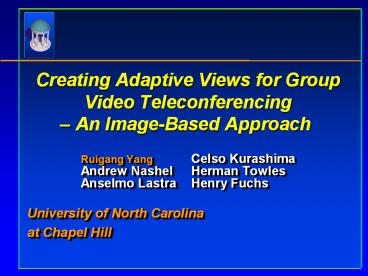Creating Adaptive Views for Group Video Teleconferencing PowerPoint PPT Presentation
Title: Creating Adaptive Views for Group Video Teleconferencing
1
Creating Adaptive Views for Group Video
Teleconferencing An Image-Based Approach
- Ruigang Yang Celso Kurashima Andrew Nashel
Herman Towles Anselmo Lastra Henry Fuchs
University of North Carolina at Chapel Hill
2
Current Teleconferencing
Transport
Display
Capture
?
3
The Office of the Future
4
Group Teleconferencing
Cameras
- Multiple persons (3-4) at each site
- Life-size, monoscopic display
- High-resolution seamless imagery
- Active view control
5
Active View Control
Provide the best approximating view
6
Active View Control
- A view synthesis problem
- Extract 3D geometry from a few cameras
- Less expensive
- Hard to get good results
- Image-based method capture many images
- Looks really good on every scene
- Need many images
7
Our Image-based Approach
- Observation Eye level remains relatively the
same during a conference session - A compact Light Field representation
- Parameterized by a 3D function (s, u, v)
8
Linear Light Field
9
LLF Rendering
- Projective Texture mapping and blending
- Tessellate the focal plane
- Project input images onto the focal plane
- View-dependent blending
New view
Focal Plane
Base image
10
Blending Function
Focal Plane
11
Samples Images
Perspective Projection
Orthogonal Projection (extreme case)
12
Sampling Analysis
- Configuration parameters
- Focal plane depth D
- Cameras FOV
- Cameras horizontal resolution W
- Inter-camera distance d
- Error term pixel drift (e)
Given the configuration parameters, and a desired
error tolerance e , what is the maximum depth
deviation ?D from the optimal depth D.
13
Sampling Analysis Result
14
More results
- Distributed System
- 11 cameras
- 6 capture PC ( 640x480)
- ROI encoded
- JPEG compression
- One rendering PC
- Roughly 1000 x 480 output
- 4-7 frames per second
15
Conclusions
- We presented a novel system designed specifically
for group video-teleconferencing. - Best approximate view for the group
- Photo-realistic results at interactive rate
- Flexible and scaleable
16
Acknowledgements
- Funding support from
- The Department of Energy's ASCI VIEWS Program
- Sandia National Laboratories USA
- Collaborators from Sandia
- Phil Heermann
- Christine Yang
- Corbin Stewart
17
The End
Thank You
PowerShow.com is a leading presentation sharing website. It has millions of presentations already uploaded and available with 1,000s more being uploaded by its users every day. Whatever your area of interest, here you’ll be able to find and view presentations you’ll love and possibly download. And, best of all, it is completely free and easy to use.
You might even have a presentation you’d like to share with others. If so, just upload it to PowerShow.com. We’ll convert it to an HTML5 slideshow that includes all the media types you’ve already added: audio, video, music, pictures, animations and transition effects. Then you can share it with your target audience as well as PowerShow.com’s millions of monthly visitors. And, again, it’s all free.
About the Developers
PowerShow.com is brought to you by CrystalGraphics, the award-winning developer and market-leading publisher of rich-media enhancement products for presentations. Our product offerings include millions of PowerPoint templates, diagrams, animated 3D characters and more.

